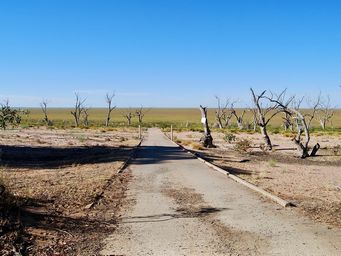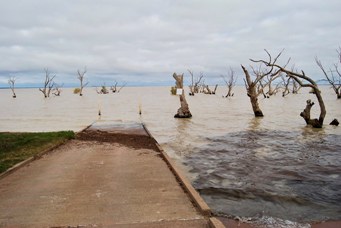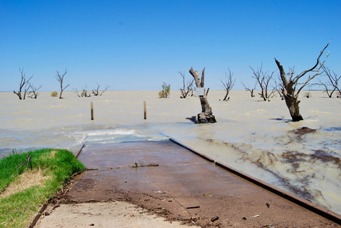Australia So Much to See
Copyright (C) 2013 AustraliaSoMuchtoSee.com. All rights reserved


Menindee, New South Wales - the varying fortunes of the lakes
When we met the Darling River in 2009 during drought years, it was to the south of Menindee, so I do not know how much water was retained
in the lakes while the river was low and not flowing. These lakes are managed by a series of weirs and regulators, so water levels
are in part manipulated. We toured the Menindee lakes system in July 2017 when water levels were falling, but the worst was
yet to come.
For a comparison, the following photos were all taken at the Sunset Strip Speedboat ramp
Drought breaking rains were received
2010. Photo at right taken in November 2010.
Lower levels again in July 2014 when the lakes were being drained by the Basin Authority and the New South Wales government.
This drainage continued through 2015.
In the dry climate of western New South Wales, the Baaka (Darling River), which has been the lifeline of the towns and stations along
the river, has not always been reliable. Even more so in recent times with the amounts of water being used for irrigation in
the catchment areas of the tributaries of the Darling River.
Waters receding in 2013, photo taken in September.





While water flows from the Darling River replenished the lakes in 2016, however draining of the lakes continued. In July 2017
we saw low levels.
June 2022 brings even higher water levels, with the gates being open as more water flows down the Darling River to the lakes.
Beneficial water flows ran into Lake Menindee in May 2021, and continued though that year.
By March 2018, Lake Menindee was dry, and livestock were grazing on the lake bed.


After unprecedented rains and flooding in eastern New South Wales and parts of Queensland including the Murray Darling catchments,
the lake system at Menindee has been at capacity, and properties around the Menindee Lakes were flooded. Photo taken January
2023.
From Water New South Wales:
From Water New South Wales:
For the past year WaterNSW has been working hard to protect the community from flooding
as much as possible, and we feel for the local people whose lives have been affected.
Over that period the Lakes have
received around 10,000 gigalitres of water – six times their capacity and more than five times what they would normally receive in
a year.